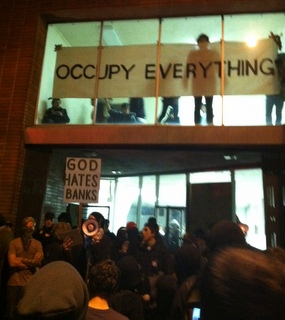Oakland Police Department’s internal communications about the Occupy Oakland movement, which the Guardian obtained through the California Public Records Act, reveal interesting patterns of what officers deem important to note about protesters.
Officers’ reported observations of the crowd generally concern activity, movement, and sometimes mood. However, there are also mentions of the percieved political affiliations of protesters. In an Oct. 24 briefing, a plainclothes officer, having strolled through the encampment, reports that “the group is diverse, made up of persons including self proclaimed anarchists, labor unions, long term homeless individuals, special cause supporters and others.”
But by Nov. 2, it seems, all other categories fall away and officers seem interested in reporting on only one perceived type of protester: anarchists.
Police make several reports in the notes of where and when they’ve noticed “anarchists” or “anarchist behavior.”
In activity logs reporting “major events” throughout Oct. 25, police include anarchist sightings in that category. In the afternoon, there is “black block (sic) spotted, approximately 12.”
When protesters briefly occupied the Travelers Aid Society building on Oct. 25, police reported “10 anarchists on the roof and inside.”
In an afternoon planning meeting Nov. 3, an officer describes the scene on the streets: “there have been reports that there were 5000 people with relatively no injuries. There seem to be people dressed in regular clothing displaying anarchist behavior.”
A press release from Nov. 2 also states that “the Oakland Police Department has identified a small group of anarchists roaming through the crowds. OPD is focused on preventing illegal activity while affording the majority their rights to assemble and march.”
It seems that those officers reporting on the crowd equate anarchists with illegal activity, and believe they can identify adherents to anarchism based on appearance and behavior.
Anarchism is a political ideology, and not illegal. Yet officers apparently count out individuals that they perceive as anarchists.
While popular stereotypes associate illegal activity such as vandalism with anarchism, many who identify with anarchist principles have not broken laws in that fashion. In fact, these documents imply that police may be associated with another illegal activity; targeting some of those they protect and serve based on political belief.

